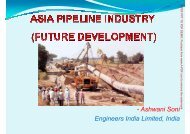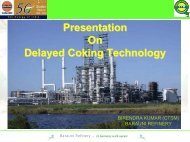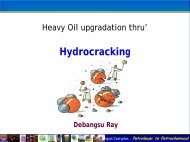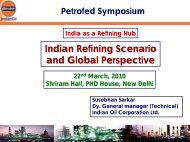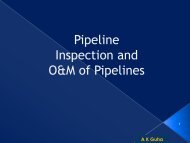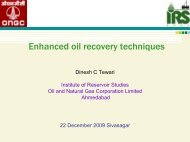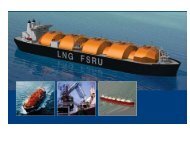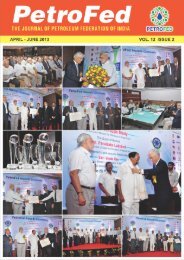Chapter -1 final last new font final - petrofed.winwinho...
Chapter -1 final last new font final - petrofed.winwinho...
Chapter -1 final last new font final - petrofed.winwinho...
You also want an ePaper? Increase the reach of your titles
YUMPU automatically turns print PDFs into web optimized ePapers that Google loves.
5<br />
www.<strong>petrofed</strong>.org<br />
Yield and Product Slate Improvement<br />
refining and petrochemicals business can be<br />
realized.<br />
Residue conversion options are being revisited to<br />
arrive at techno commercially feasible options to<br />
increase overall distillate yields beyond 80-82%<br />
and reduce the production of heavy ends. With<br />
an increasing thrust towards value addition,<br />
configuration studies are now looking at higher<br />
•<br />
•<br />
Benefit from the higher demand growth and<br />
return for petrochemicals versus fuels.<br />
Control over petrochemical feedstock costs<br />
helps to maintain margins in petrochemical<br />
products<br />
capacities (low cost expansion) to derive benefits<br />
of economies of scale and possible integration<br />
with a petrochemical complex, so that more value<br />
can be added to the refining operations. Such<br />
integrations add significantly to the refining<br />
• Reduced capital and operating costs on<br />
account of shared infrastructure and reduced<br />
emissions as compared to standalone<br />
facilities.<br />
margins but they come at a price. The approach to<br />
such integrations would be to phase the<br />
investments e.g. initially in a refinery and<br />
aromatics complex and then add the olefins<br />
production facilities, an approach that has been<br />
followed by the Panipat refinery of M/s Indian Oil<br />
corporation Ltd. At times it may make more sense<br />
to follow the reverse sequence, i.e., set up the<br />
olefins/aromatics production facilities based on<br />
feed from other sources and gradually integrate<br />
backwards with refining. Figure 2 illustrates some<br />
possible linkages between a refinery and a<br />
petrochemicals complex.<br />
It is not surprising that a number of mega projects<br />
envisaging the setting up of integrated refinery<br />
cum petrochemical projects are at different stages<br />
of implementation. The Reliance Refinery at<br />
Jamnagar and the Panipat Refinery of IOCL are<br />
two leading examples. The Paradip Refinery<br />
Project of IOCL is planned on similar lines, but<br />
with a phasing of expenditure. A number of other<br />
feasibility reports have been prepared for projects<br />
that envisage similar refinery/petrochemical<br />
linkages. It is understood that similar facilities are<br />
also planned to be set up in China and Saudi<br />
Arabia.<br />
Figure 2: Possible Refinery/Petrochemical linkages<br />
Gasification for residue Upgrading<br />
The refinery/petrochemicals linkage offers a<br />
number of other benefits, which include: As discussed earlier, residue upgrading projects<br />
•<br />
•<br />
Flexibility to shift the balance of production<br />
between fuels and petrochemicals<br />
Advantage of different economic cycles of the<br />
are being pursued quite actively, with the objective<br />
of monetizing heavy residual streams. The<br />
technology options could involve either Hydrogen




